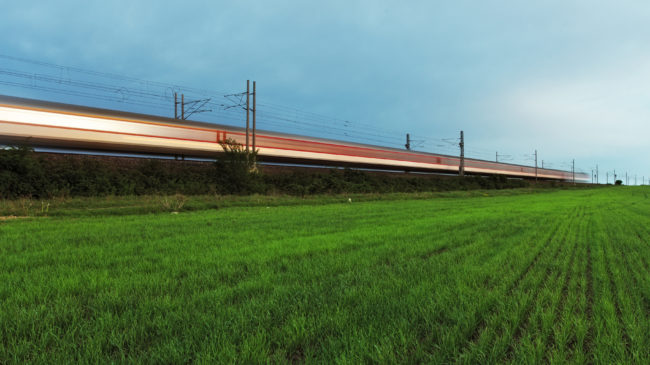For more than 30 years, public and private entities have been trying to build high-speed rail in Texas. In 2014, Texas Central proposed building a 240-mile high-speed rail line between Dallas and Houston with speeds of 180 miles per hour or higher. For years, Texas Central promoted its high-speed rail plan as a privately-financed project that would not require any public funding. While this made Texas Central’s proposal initially seem attractive to many, over time most experts came to believe the project would need significant subsidies due to its very high ridership projections and underestimated costs.
COVID-19 has resulted in new complications for Texas Central’s high-speed rail plan. The global coronavirus pandemic has reduced the popularity of long-distance travel. The fear of contracting the virus combined with decreased economic activity has led to unprecedented declines in passenger traffic. At COVID-19’s peak, the number of Americans flying decreased by 95 percent and roadway traffic volumes declined by 60 percent. Many private bus lines also suspended operations.
As Texas, currently dealing with a surge in coronavirus cases, reopens, travel will recover to an extent. However, most experts don’t expect passenger travel volumes to return to pre-COVID-19 levels over the short-term. Aviation experts expect it will take four or more years for demand to match pre-COVID levels. Airbus, one of the two large plane manufacturers, believes it will take five years for aviation travel to return to normal.
There are several reasons for this expected slow recovery. COVID-19 has severely damaged the economy to an extent still not fully known. More than 30 million Americans lost their jobs between mid-March and late April 2020, leading to a national unemployment rate of over 10 percent. In past recessions, long-distance travel declined because businesses reduced expenses and Americans took fewer vacations due to a decline in disposable income. While these prior travel declines were due solely to economic reasons, the present travel declines stem not only from a depressed economy but also from fear of contracting COVID-19.
Texas Central’s Dallas to Houston line is not expected to be operational until 2026—hopefully well after the threat from COVID-19 has subsided. However, several of the COVID-19-related changes may become permanent. Amtrak is disinfecting all trains and stations throughout the day. Airlines are using electrostatic spraying to sanitize the entire airplane before each flight. Many airlines have committed to this standard for the long-term, increasing their costs.
Potential customers will expect high-speed rail lines to provide the same service. Additionally, food service options are expected to change. For the short term, both Amtrak and airlines have ended traditional food service. When food service resumes, the costs to provide it will increase due to new cleaning, handling, and cooking policies. Customers will expect Texas Central to make this change as well.
Further, many experts believe the changes to long-distance travel are permanent. Some in-person business trips will be replaced by Zoom webinars. Some families will choose to take vacations closer to their homes so they can drive. These changes will depress ridership demand for high-speed rail. Given Texas Central’s soaring construction costs, any loss in ridership reduces the project’s viability.
Although some advocates are encouraging federal stimulus funding for transportation projects, transportation is a poor match for stimulus spending. Mega-projects, such as Texas Central’s high-speed rail line, require planning, years of environmental reviews and legal challenges, regulatory approvals, and other pre-construction preparation activities (such as moving utilities). All of these time-consuming tasks must be accomplished and overcome before construction can begin. With respect to Texas Central, its estimated service date has already suffered years of delay and appears to be headed toward many more. Currently, Texas Central estimates its high-speed rail system will commence passenger service in 2026.
Texas Central has secured only $450 million of the more than $30 billion needed to build the project, while recently laying off nearly 30 employees. Given its financial challenges, Texas Central will likely have to rely on stimulus funding or a multi-billion dollar Railroad Rehabilitation and Improvement Financing (RRIF) loan that lacks taxpayer protections.
Combined with land acquisition, environmental permitting, and other regulatory obstacles, Texas Central’s financial woes have pushed the expected start of passenger service to 2026 at the earliest. In the meantime, changes caused by the pandemic are expected to decrease business travel and demand for new travel modes even further. Absent significant, near-term financial support from the private sector, Texas Central should end its project. If Texas Central chooses to march onward, lawmakers and taxpayers must ensure it does not receive stimulus funding or an RRIF loan.
Finally, lawmakers, taxpayers, and any federal or state agencies involved with the project are encouraged to heed the wisdom of infrastructure experts who have examined the project’s financial feasibility instead of blindly adopting the unsupported assertions of Texas Central. If they do not, a repeat of the ongoing high-speed rail fiasco in California is almost certain to occur.
Full Brief — COVID-19 And Soaring Costs Are New Challenges for Texas High-Speed Rail Line

